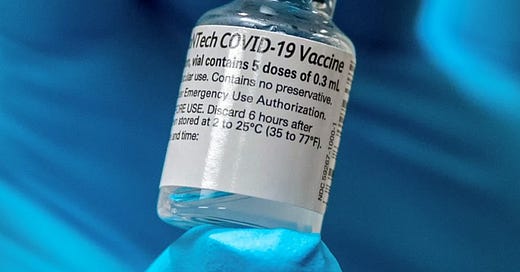No. 3 - Child vaccinations lag -- why were they not given in schools?
Here's what the data say six weeks after child vaccinations have been available.
COVID-19 vaccines have been available in Canada for children aged 5-11 for six weeks.
Most jurisdictions chose not to administer the vaccine in schools, preferring instead public clinics, doctors’ offices or pharmacies. I argued back in November that this strategy would lower take up and increase vaccine inequity. Schools should have been the backbone of the child vaccination campaign, accompanied by public clinics as a second option for parents and guardians who wanted to accompany their children, but mostly, politicians and public health shunned vaccines in schools.
Only two of Canada’s 13 provinces and territories gave vaccines in schools: Newfoundland and Labrador, and Quebec. And unsurprisingly, six weeks later, they, along with Nova Scotia, have the highest rates of vaccination among 5-11 year olds.
Newfoundland and Labrador has vaccinated the most 5-11 year olds, at 69.3%. The province with the lowest rate? Alberta, at 35%. In the second spot is Nova Scotia at 58%, a province where children were vaccinated in pharmacies and public clinics. Next is Quebec, at 56.78%. NWT is at 51% and the rest of the provinces and territories are all below 50%.
I’m curious about how Nova Scotia managed to get so many kids vaccinated so quickly without doing it in schools. There might be a hint in their 12-17 year old (one dose) vaccination rate, which is far higher than anywhere else in Canada save Newfoundland and Labrador, at 96%. The next closest jurisdiction for this age category is British Columbia at 89%. But unlike Nova Scotia and Newfoundland and Labrador, this high rate for teenagers is not followed by a high child vaccination rate: their 5-11 vaccination rate is 38% which puts them in eleventh of thirteen place.
Also interesting is how Quebec’s vaccine distribution for children essentially flatlined when schools closed for the holidays. With schools now returning online, in-school vaccination is no longer an option (especially to make up for vaccine clinics closed for snow days, like what happened at my kids’ school, for example). The province relied too much on the in-class distribution, clearly, as the numbers since December 22 have only climbed by three per cent (and as children must compete with other children looking for their second dose or adults who are mad that they need to be vaccinated to buy a bottle of Johnnie Walker Red).
Leaving vaccination up to clinics alone though has been a recipe for inequality. The parents with the most resources, time and access to the healthcare system had the ability to more quickly book vaccine appointments. In Toronto, The Local crunched the numbers to show that in the wealthiest neighbourhoods, between 65 - 70% of 5-11 year olds had been vaccinated by December 5. Today, not even 50% of Toronto kids are vaccinated.
This mirrored similar inequality that The Local tracked in the adult vaccination roll-out too. Rather than targeting the communities that had been hit hardest by COVID-19, the people who had the most access to resources and time, were vaccinated first. Knowing this, it’s stunning that every school in the city wasn’t provided with a few days of a vaccine clinic.
In-school vaccination isn’t a panacea, but it also should have been the obvious go-to for provincial, territorial and local public health unit vaccine campaigns. With strong community outreach and working parent-friendly public clinics, these numbers would have been far higher than they currently are. And there was no excuse to be where we are today: universal access through school would have evened out some of the inequity inherent in the free-for-all approach taken by so many jurisdictions.
So while politicians do focus groups, surveys or whatever (I have it on good authority…) to find out why vaccinate rates for this age group lag, or while they pay for outings to zoos, sports facilities or whatever to try and boost child vaccination, the answer is obvious. Or, it was obvious. It may be less obvious with schools closed but even then, closed schools are empty child-centric spaces that could all have vaccine clinics set up in them during the hours of online school. It of course won’t catch everyone but hey, it’s better than online school, right?





Yup all they had to do was send home permission slips and it would’ve saved a lot of time stress and money